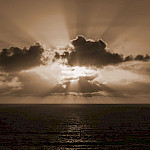On His Head, Many Diadems
In that wondrous vision given to the lone prisoner of Patmos, in which the opened heavens disclose the Son of Man returning to earth for judgment, accompanied by the host of heaven, He is described as “King of kings and Lord of lords.” And on “His head are many crowns.” The word here used for “crowns” is diadema—a regal crown, the symbol of imperial dignity, as contrasted with stephanos—the victor’s crown, won in the race, or contest, the reward of merit, the symbol of triumph.
Already the glorified Lord in heaven wears His Victor’s Crown (Heb. 2:9), for His triumph is already complete His victory has been won. But the hour of His coronation with His regal crowns, which are His right, is yet to come. It will be the public response of heaven to the dishonour He suffered on earth. Men crowned the Christ of God with a crown of thorns, and bowed the knee before Him in mockery. God will set upon His brow, once so rudely wreathed with thorns, the Royal Diadem of heaven, investing Him with the glory and the power which to Him belongs as “King of kings.” He will bring Him back to the world that cast Him out, and to the very scenes in which the Cross once stood, arrayed in royal majesty, crowned with His “many diadems,” to be owned and acknowledged as “Lord of all.” And where the ruby blood drops of His Passion once sat, the “many crowns”—symbolic of His earthly rights—will then shine in their unfading beauty and unsullied splendour. Twice before this, the word diadema is found in the Book of Revelation.
Once, in chapter 12:3, on the head of the Dragon; once, in chapter 13:1, on the head of the Beast, the devil’s representative and his ruler of the kingdoms of earth. But the day will come when He, whose right it is to reign, will come to his own, and then
The crowns that were wreathed on the False One’s brow,
Shall be worn by their rightful Lord.
The diadema—the royal crown of Creation’s lord, will be His, worn on that day of its release from its curse and the bondage of its corruption. Lost to Adam in the day of his fall, regained by Christ in the hour of His triumph. Israel’s crown will also be on His brow, for the returning conqueror is the Man of Calvary, above whose Cross they wrote in scorn, “Jesus of Nazareth, the King of the Jews.” And the crowns of Gentile nations, whose rulers come to own Him King, and lay their riches at His feet (Ps. 82:10), will be His also on that day. He is worthy of them all.
And then the weary earth and the restless nations shall know the benign rule of the Prince of Peace. But not till then. No, never! For how can the earth be at rest, or the world “break forth into singing” (Isa. 14:7), while the great usurper wears its regal crown, and claims to be its prince and ruler? But judgment must soon clear the scene, and the great usurper will then pass to his doom. Then will heaven’s hallelujahs rise in honour of her rightful King, and the call will echo from the eternal throne outward, onward, to the uttermost bounds of creation, all joining in the joyful song—
Bring forth the Royal Diadem,
And crown Him, Lord of all.
Article series: Our Glorious Lord
Christ, the Motive in Service The Glorified Lord – Walking Amid the ChurchesPrevious article Next article




